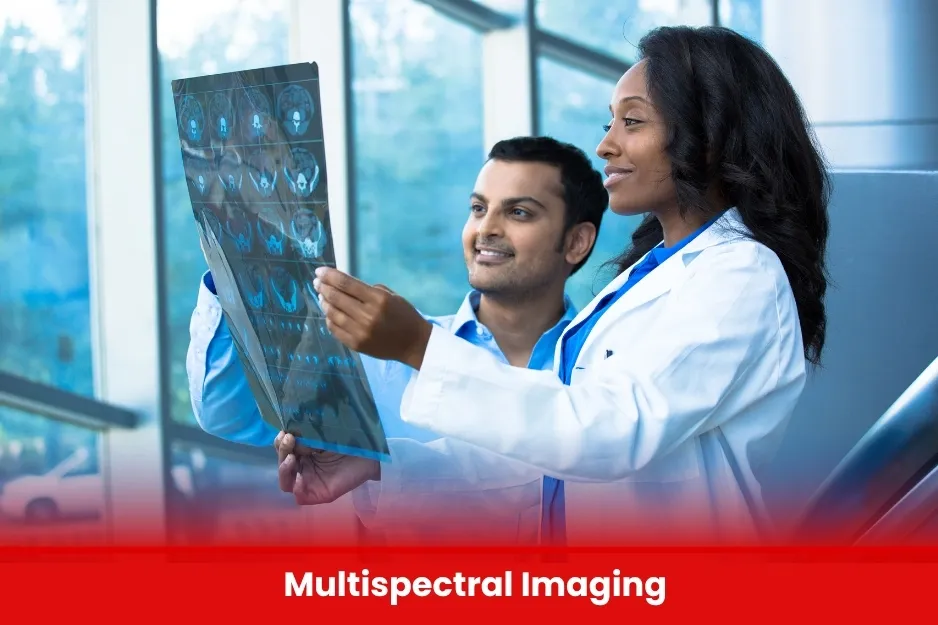Multispectral imaging
BURRAQ UK is a forward-looking initiative focused on leveraging advanced technologies such as multispectral imaging to support applications across defense, agriculture, environmental monitoring, and geospatial intelligence. By integrating cutting-edge sensors and imaging platforms, BURRAQ UK aims to deliver data-driven solutions that enhance situational awareness and decision-making in complex operational environments.

Aim of Multispectral imaging
The aim of BURRAQ UK is to develop and deploy advanced remote sensing technologies — particularly multispectral imaging systems — to provide accurate, high-resolution data for applications in defense, agriculture, environmental monitoring, and geospatial intelligence. By integrating cutting-edge imaging solutions with modern aerial and ground-based platforms, BURRAQ UK strives to enhance situational awareness, support strategic decision-making, and contribute to sustainable technological innovation across multiple sectors.
Course Overview
Multispectral imaging
Academic Qualifications:
- A minimum of a Bachelor’s degree in one of the following fields (or related disciplines):
- Remote Sensing / GIS
- Aerospace / Avionics Engineering
- Electrical / Electronics Engineering
- Computer Science / Software Engineering
- Environmental Sciences / Earth Sciences
- Physics / Optics / Imaging Technologies
Technical Skills:
- Basic understanding of remote sensing principles and spectral imaging.
- Familiarity with tools/software such as ENVI, ERDAS Imagine, ArcGIS, QGIS, or image processing platforms (preferred).
- Experience with UAV operations, data analysis, or Python/MATLAB programming is an added advantage.
| Course Code | Curriculum Title | Credit | DLH |
|---|---|---|---|
| BUK1117-2 | Principles of Multispectral Sensors and Platforms | 2 | 6 |
| BUK1117-3 | Data Acquisition & UAV Operations | 2 | 6 |
| BUK1117-4 | Image Processing & Analysis | 2 | 6 |
| BUK1117-5 | GIS Integration and Spatial Analysis | 2 | 6 |
| BUK1117-6 | Applications in Defense, Agriculture & Environment | 2 | 6 |
Module 1: Introduction to Remote Sensing & Multispectral Imaging
- Fundamentals of remote sensing
- Overview of electromagnetic spectrum
- Spectral signatures of natural and man-made objects
- Applications across different sectors
Module 2: Principles of Multispectral Sensors and Platforms
- Sensor types and spectral bands
- Multispectral vs. hyperspectral systems
- Payload integration on UAVs, satellites, and ground systems
- Calibration and radiometric correction
Module 3: Data Acquisition & UAV Operations
- UAV flight planning for remote sensing missions
- Sensor mounting, stabilization, and payload management
- Legal and safety considerations (UK CAA regulations)
- Field-based data collection exercises
Module 4: Image Processing & Analysis
- Pre-processing: geometric and radiometric correction
- Image classification (supervised & unsupervised)
- Vegetation indices (e.g., NDVI), water indices, and thermal mapping
- Change detection and object-based image analysis (OBIA)
Module 5: GIS Integration and Spatial Analysis
- Importing multispectral data into GIS platforms (ArcGIS/QGIS)
- Layering, digitizing, and spatial modeling
- Terrain analysis and land use mapping
- Real-world case studies and applications
Module 6: Applications in Defense, Agriculture & Environment
- Surveillance and target detection
- Precision agriculture and crop health monitoring
- Environmental impact assessment
- Disaster response and early warning systems
Module 7: Project Work / Capstone
- Students or participants apply acquired skills to a real-world problem
- Data acquisition, analysis, and reporting
- Final presentation and evaluation
- Students or participants apply acquired skills to a real-world problem
- Data acquisition, analysis, and reporting
- Final presentation and evaluation
- All Modules within this qualification are assessed internally by the approved training Centre and externally verified by BURRAQ UK. The program uses a criterion-referenced assessment approach to ensure that learners successfully meet all required learning outcomes.
- A Pass in any unit is granted only when the learner submits valid, reliable, and authentic evidence that demonstrates achievement of the assessment criteria. The Assessor is responsible for reviewing this evidence and confirming that the learner has attained the expected standard.
